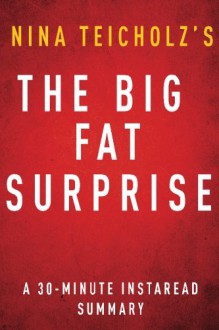The Big Fat Surprise by Nina Teicholz - A 30-minute Instaread Summary: Why Butter, Meat and Cheese Belong in a Healthy Diet
PLEASE NOTE: This is a summary of the book and NOT the original book. The Big Fat Surprise by Nina Teicholz - A 30-minute Instaread Summary Inside this Instaread Summary:Overview of the entire bookIntroduction to the Important people in the bookSummary and analysis of all the chapters in the...
show more
PLEASE NOTE: This is a summary of the book and NOT the original book. The Big Fat Surprise by Nina Teicholz - A 30-minute Instaread Summary Inside this Instaread Summary:Overview of the entire bookIntroduction to the Important people in the bookSummary and analysis of all the chapters in the bookKey Takeaways of the bookA Reader's Perspective Preview of this summary: IntroductionThe author had the luxury of approaching the nutritional science field as an open-minded individual with no affiliation or funding from any institutions or persons with deeply entrenched views. The result is some alarming information about the ways that nutrition has been misinterpreted for decades. The supposed health hazards of saturated fats found in butter, eggs, and meat have not been substantiated by reliable science. Science supports the fact that the body is healthiest on a diet rich in fat.Chapter 1Vilhjalmur Stefansson was an anthropologist who lived with the Canadian Arctic Inuit in 1906, eating almost nothing but meat for an entire year. He later wrote the controversial book, Not by Bread Alone, in which he explained that the Eskimos seemed to be the healthiest people he had ever encountered despite their sedentary lifestyles and diets almost void of vegetables and carbohydrates. In 1928, he and a co-worker began a drastic experiment together. They vowed to consume only meat and water for a year. At the end of the year, both men were said to be in perfect health.In the early 1960’s, doctor and professor of biochemistry, George Mann, took a team from Vanderbilt University to Kenya to study the Masai people who ate and drank nothing but meat, blood, and milk. Fat from animal sources was the source of 60 percent of their calories. The blood pressure and weight of these warriors was 50 percent lower than men of the same age in the United States. If American beliefs about animal fat were true, Mann should have seen an epidemic of heart disease among the Masai. However, he found little evidence of heart disease among them.For decades, the American Heart Association (AHA), the United States Department of Agriculture (USDA), and other expert groups have recommended obtaining daily calories from fruits, vegetables, and whole grains. The public has been advised to minimize animal fats and eliminate red meat from their diets despite Mann’s findings and similar evidence from other studies. In the early 1900’s, Sir Robert McCarrison was the director of nutrition research for the British government in the Indian Medical Service. He wrote in detail about the fact that the Sikhs and the Hunzas of northern India did not suffer from cancer, appendicitis, or ulcers like the Western nations did. He also noted that their great health stood in stark contrast to other groups in the southern part of India who lived on mainly white rice and little dairy or meat. Anthropologist Ales Hrdlicka studied the Native Americans of the Southwest between 1898 and 1905. He observed that they ate mainly buffalo, were extremely healthy, and lived very long lives without suffering from malignant diseases.A detail of these early studies often buried, or overlooked, is that humans today eat the muscle of the animal, but this was not always the case. Early humans preferred the fat of the animal over its muscle meat. These viscera are higher in saturated fat. It is hard to even imagine eating this way when contemporary standards advise the public to do the opposite...
show less

